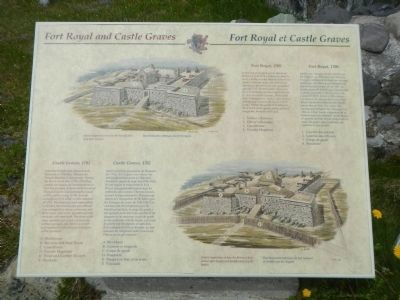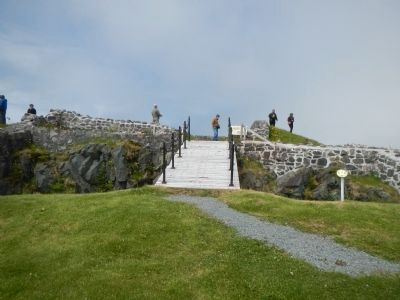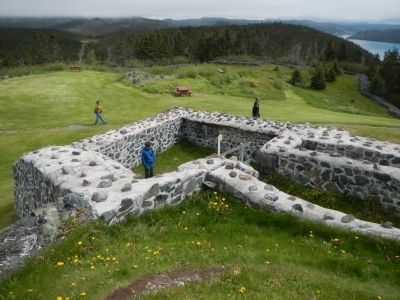Placentia in Avalon Peninsula, Newfoundland, Newfoundland and Labrador — The Atlantic Provinces (North America)
Port Royal and Castle Graves
Port Royal et Castle Graves
Inscription.
English
Following an English naval attack on Plaisance in 1692 the French decided to erect a hilltop fortification to defend the town’s seaward approach. Fort Royal was begun the next year and completed around 1703. At 100 metres above sea level, Fort Royal was too high to be hit by ship-mounted cannon, yet it could rain “plunging fire” down upon ships attempting to attack the town or Fort Louis. Within the walls of Fort Royal the French had a guard room, powder magazine, barracks and a jail.
1. Soldier’s Barracks
2. Officer’s Barracks
3. Guardhouse
4. Powder Magazine
Artist’s impression of how the French fort may have looked
After the British took possession of Placentia in 1714 the allowed the French defences to deteriorate. During the Seven Years War (1756-1762) they carried out repairs and modifications to Fort Royal, many of them while Governor Thomas Graves was temporarily based in Placentia owing to the French occupation of St. John’s in the summer of 1762. The barracks were replaced by a wooden blockhouse, the guardhouse was enlarged for use as a barracks and store room, and a new guardhouse and stockade wall were built. The stone walls were repaired and given a wood and earthen parapet, and the revived fort was renamed Castle Graves in honour of the governor.
A. Blockhouse
B. Barracks and Store Room
C. Guardhouse
D. Powder Magazine
E. Wood and Earthen Parapet
F. Stockade
Artist’s impression of how the fort may have looked after repairs and modifications by the British.
French
Après une attaque navale menée par les Anglais sur Plaisance en 1692, les Français décidèrent d’ériger un ouvrage fortifie sur la colline pour défendre les approches maritimes de la ville. La construction de Fort Royal commencée l’année suivante, s’est poursuivie jusqu’en 1703. Situé à 100 mètres au-dessus du niveau de la mer, Fort Royal était hors d’atteinte des tirs de canon des navires. Par contre, les navires qui tentaient de s’attaquer à la ville ou à Fort Louis, risquaient de se trouver sous une veritable «pluie de feu». L’enceinte de Fort Royal renfermait un corps de garde, une poudrière, des casernes et une prison.
1. Caserne des soldats
2. Caserne des officiers
3. Corps de garde
4. Poudrière
Représentation artistique du fort français.
Après avoir pris possession de Plaisance en 1714, les Anglais ont laissé les fortifications françaises à l’abandon. Pendant le guerre de Sept Ans (1756-1762), ils ont réparé et transformé le Fort Royal, plus particulièrement sous les orders du gouverneur Thomas Graves, envoyé temporairement à Plaisance en raison de l’occupation de St. John’s par les Français, au cours de l’été 1762. Les casernes ont été remplacées par un blockhaus en bois, les corps de garde a été agrandi pour servit de caserne et de magasin et un nouveau corps de garde et une palissade ont été érigés. Les murs de pierre ont été réparés et renforcés d’un parapet de bois et de terre. Le fort restauré fut rebaptisé Castle Graves en l’honneur du gouverneur.
A. Blockhaus
B. Caserne et magasin
C. Corps de garde
D. Poudrière
E. Parapet en bois et en terre
F. Palissade
Représentation artistique de fort restauré et modifié par les Anglais.
Erected by Parks Canada.
Topics. This historical marker is listed in this topic list: Forts and Castles. A significant historical year for this entry is 1709.
Location. 47° 15.062′ N, 53° 58.293′ W. Marker is in Placentia, Newfoundland and Labrador, in Avalon Peninsula, Newfoundland. Marker can be reached from Castle Hill Road. Touch for map. Marker is in this post office area: Placentia NL A0B, Canada. Touch for directions.
Other nearby markers. At least 5 other markers are within walking distance of this marker. (Fort Royal) (a few steps from this marker); Fort Royal (Plaisance) (a few steps from this marker); Castle Hill (within shouting distance of this marker); a different marker also named Castle Hill (about 90 meters away, measured in a direct line); Fort Frederick (approx. 0.8 kilometers away).
More about this marker. This marker is located on the wall ruins of Fort Royal in Castle Hill National Historic Site.
Credits. This page was last revised on June 16, 2016. It was originally submitted on November 19, 2014, by Barry Swackhamer of Brentwood, California. This page has been viewed 448 times since then and 34 times this year. Photos: 1, 2, 3. submitted on November 19, 2014, by Barry Swackhamer of Brentwood, California. • Bill Pfingsten was the editor who published this page.


